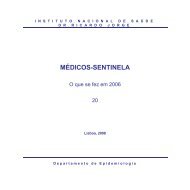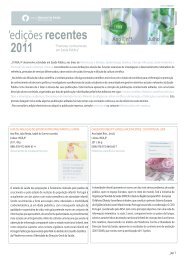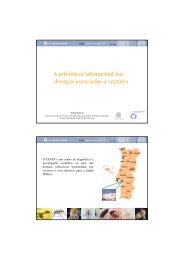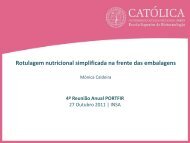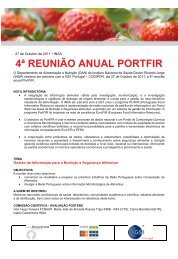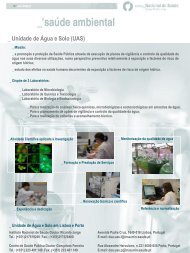European Society of Mycobacteriology - Instituto Nacional de Saúde ...
European Society of Mycobacteriology - Instituto Nacional de Saúde ...
European Society of Mycobacteriology - Instituto Nacional de Saúde ...
You also want an ePaper? Increase the reach of your titles
YUMPU automatically turns print PDFs into web optimized ePapers that Google loves.
PP-16<br />
GENOTYPING OF Mycobacterium tuberculosis<br />
IN NORTHWEST OF PARANÁ STATE OF BRAZIL<br />
Leite, Clarice Queico Fujimura 1 , Nogutia, Erika N 2 , Malaspina, Ana Carolina 1 , Santos,<br />
Adolfo Carlos Barreto 1 , Hirata, Rosáro DC 3 , Hirata, Mário H 3 , Cardoso, Rosilene Fressatti 2<br />
1 - São Paulo State University<br />
2 - Maringá State University<br />
3 - University <strong>of</strong> São Paulo<br />
Introduction<br />
Worldwi<strong>de</strong>, tuberculosis (TB) remains the most frequent and important infectious disease causing morbidity and <strong>de</strong>ath.<br />
The molecular epi<strong>de</strong>miology study using different techniques revolutionized the un<strong>de</strong>rstanding <strong>of</strong> the epi<strong>de</strong>miology <strong>of</strong><br />
tuberculosis allowing comparison between strains <strong>of</strong> Mycobacterium tuberculosis and tracking the movements <strong>of</strong> individual<br />
lines. We reported here the first insight about the genetic diversity <strong>of</strong> M. tuberculosis in northwest <strong>of</strong> Paraná State,<br />
south <strong>of</strong> Brazil. This knowledge encourages additional prospective epi<strong>de</strong>miological study for evaluation <strong>of</strong> the Regional<br />
Tuberculosis Control Plan in this setting.<br />
Objectives<br />
Provi<strong>de</strong> information about the genetic diversity and prevalent genotype <strong>of</strong> Mycobacterium tuberculosis and compare the<br />
usefully <strong>of</strong> two methodologies in epi<strong>de</strong>miological study <strong>of</strong> tuberculosis in low en<strong>de</strong>mic area in south <strong>of</strong> Brazil. Material<br />
and Methods: We used spoligotyping and MIRU-VNTR typing to genotype M. tuberculosis isolates.<br />
Results<br />
The 93 isolates analyzed by spoligotyping were divi<strong>de</strong>d into 36 different patterns and 25 were <strong>de</strong>scribed in the SpolDB4.0<br />
database. Latin American and Mediterranean, Haarlem and T family were responsible for 26.9%, 17.2% and 11.8%, <strong>of</strong><br />
tuberculosis cases respectively. From the 84 isolates analyzed by MIRU-VNTR typing, 58 showed unique pattern and 26<br />
belonged to 9 clusters. The MIRU loci 40, 23, 10 and 16 were the most discriminatory. MIRU-VNTR and spoligotyping<br />
combined showed 85.7% <strong>of</strong> discriminatory power (HGI=0.995).<br />
Conclusions<br />
Spoligotyping and MIRU-VNTR typing combined are useful tool for epi<strong>de</strong>miological study in this low en<strong>de</strong>mic setting in<br />
south <strong>of</strong> Brazil and tuberculosis predominantly <strong>de</strong>velops through reactivation <strong>of</strong> latent infection.<br />
88 ESM 2009



